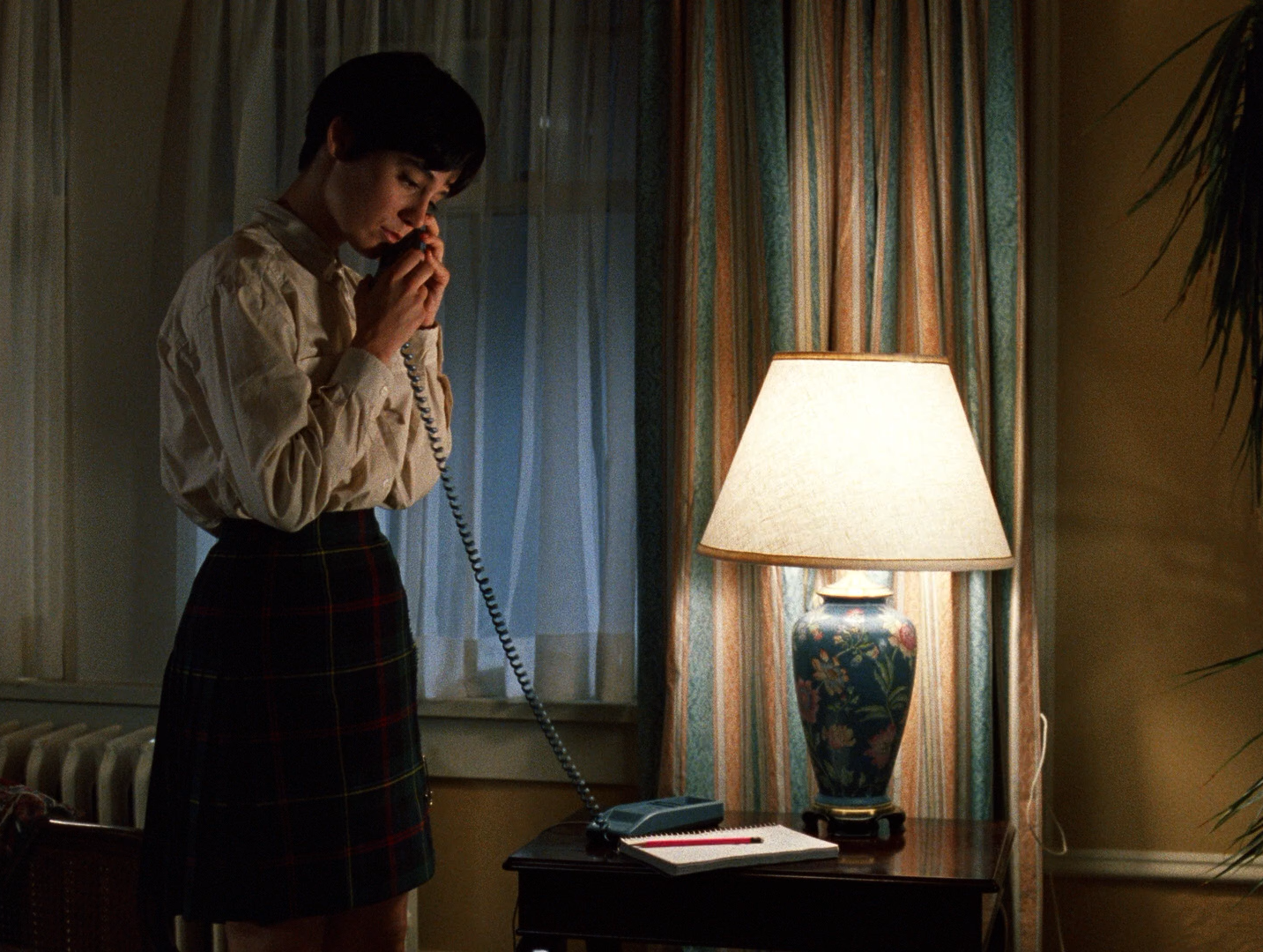Editorials
Gaslighting the Final Girl in ‘When a Stranger Calls Back’
November 23rd, 2020 | By Gem Seddon

What generates fear for a final girl? The terror in stalk-and-slash films tends to stem from the treacherous whims of its boogeyman, the villain who won’t stop until a trail of teen bodies lies in his wake. The Big Bad who hides the horror of his true self behind a mask. That’s not the case in director Fred Walton’s When A Stranger Calls Back.
What stokes fear in this 1993 chiller isn’t the brazen butchery of a psychopath (Scream would go on to blend these two concepts perfectly a mere three years later). No, it’s the quiet cunning of an unhinged man eager to make his victims match his own absent sense of self.
The Unkindness of Strangers
For Julia Jenz (Jill Schoelen), terror originates from the more unsettling circumstance — and for many women, a sadly all-too-true reality — of being repeatedly forced to question her own sanity. But the empowerment of Jenz stems from her deep-seeded resolve and a unique relationship seldom found in gaslit horror films. Unlike other final girls, she has someone who genuinely believes her.
Julia is tormented over and over throughout the movie’s 90 minutes. It’s not that she narrowly escapes with her life in the opening sequence, nor that the children she babysits are kidnapped, never to be seen again. She experiences a fate somehow worse than death because she cannot trust herself thanks to the insufferable mastermind behind her prolonged ordeal.
Let me back up a little.
This made-for-TV sequel riffs off the same babysitter and “man upstairs” urban legend as its predecessor. Despite the fact this movie takes place 15 years after the original, writer-director Walton keeps the premise fresh by doing away with technology altogether. He supplants the concept of “the calls are coming from inside the house” with a wholly new one; there are no calls at all because the stranger cut the phone line.
The movie’s thirty-minute opening is an exercise in pure, nerve-shredding tension. Shortly after settling in for a quiet night of babysitting, Julia hears a knock at the door. She refuses to open it, but offers to ring the auto club for the soft-spoken man outside having car trouble. One snag: the phone is dead. She fakes the call and tells the stranger help is on the way.
She switches off a teakettle only for its eerie whistle to siren throughout the house ten minutes later. She makes sure the back door is locked, only for it to yank open the next scene. A note pinned to the fridge, suddenly gone.
“Come on out, Julia,” he instructs as the scene reaches its climax. “I never told you my name!” she cries, until she finally snaps, her voice cracking at last, “Where are you? What have you done with them?” In pushing her over the edge – did she tell him her name after all? – he sows the seeds of doubt in Julia which plague her until she reaches college. That night she escapes with her life, but so does he.
Living With Trauma
Cut to five years later, and we’re greeted to another home invasion. This time, Julia’s not confronted by a man in her apartment, only evidence of him that sends her straight to the local police department. Her claims are almost laughably mundane. When she tells the police that she’s discovered a child’s shirt hanging in her closet, the police brush her off. She elaborates. A book of poems was moved on her bookshelf.
This only further stokes their incredulity. “Didn’t you say you keep your door triple-bolted and live on the third-story?” one cop asks, before another chimes in, eyebrow raised, “Lot of effort for someone to move a book.” They have a point.
The news won’t report on an alarm going off when someone didn’t set it. No-one’s going to make a big fuss about a book being moved. Or a shirt you’ve never owned hanging in your closet.
The stranger knows that; and he knows the police won’t take her seriously. The saddest, most infuriating statement the film makes is eerily prescient to elements of the #MeToo movement: compassion for victims is only available through shared sympathetic experience. The sole person in the movie who believes Julia is Carol Kane’s original survivor Jill. She returns here as a women’s crisis counselor. Why does she help Julia? Why is she a counselor? Because she endured the same.
Julia seeks guidance from Charles Durning’s retired detective John, the cop from the first film whom Jill loops in to help. “Every night I go to bed, hoping that tomorrow, somehow, things are gonna be different, that I’m gonna be somebody else, with a different life. Somebody with friends, a person with a future who isn’t alone. A person who maybe has someone, and then I wake up.”
Her earnestness (thanks to Schoelen’s understated performance) is not only endearing, but downright heart-breaking. Even after hearing the desperate cries of a woman on the edge of throwing in the towel – looking for someone, anyone, to tell her not to – John refuses to acknowledge her struggle.
Gaslighting the Survivor
When A Stranger Calls Back is a frustrating watch on this front. Every single man supposedly designated to protect Julia fails to even consider her claims, because they cannot fathom that a person would do this. She isn’t solely victimized by the stranger; she’s victimized over and over by each of the men who doubt the veracity of her assertions.
Every single man is careless with her life, unable to hear her desperately ask for help. The cops don’t bother to request the report from upstate about the events of five years earlier; “Call the university, tell them we have a hysterical coed on our hands,” says the detective.
Later in the film, Julia is shot with the same gun she bought for protection; we will never know whether she or the stranger pulled the trigger. This time it’s Jill whom no one believes. She is now a stand-in for comatose Julia as the movie’s final girl and the co-ed’s lone defender.
By the time you encounter scenes between Jill and Julia, it’s a blessed release. You’re so desperate for someone to show a modicum of basic human kindness and caring toward this oddball loner, that when the pair hug, it offers the viewer a relief. Understanding. A willingness to listen. That’s all Julia wants, and that’s what she finds in Jill. When she wakes in the night, to “something at the window,” she calls Jill immediately. “Julia, don’t assume anything. Put the phone down and secure the apartment.”
But despite their fledgling friendship, the damage has been done. Those seeds sown years before now bear the fruit of the stranger’s making, threaded rotten into her cracked psyche. “I probably imagined this whole thing,” she sighs before hanging up the phone.
Finding Strength Within
Unlike heroines who engage their primal warrior instinct before slaying the bad guy, Julia’s arc, and indeed, the point of the movie, isn’t flamboyant. It dwells not in showy moments of bravado, but in simple acts that make her feel in control; much like the stranger whose micro-manipulations do the opposite.
For a woman whose teenage experience scarred her to the bones, she hasn’t been stripped entirely of longing, far from it. She’s both strong and vulnerable, desperate for a life and willing to fight. Trouble is, the stranger knows her weaknesses, her strengths, her peculiarities in such intimate detail, he’s able to manipulate them.
She pushes forward, despite the stranger breaking her spirit, her belief, again and again. She is tormented. She is stalked. She is beaten. She is hospitalized. Yet the terror Julia endures, somehow, never brittles her. She assimilates those traumas into herself.
Gaslighting is hardly new terrain for genre heroines. Women in horror movies are frequently forced to question their own instincts and relinquish control to the “better judgment” of men. Their position as victim or monster seldom allows them room to occupy any other space, yet the film offers an inbetween. A duo of beat-up final girls, Julia and Jill both survive despite every man in the movie attempting to pigeonhole them as one or the other.
Conclusion
When A Stranger Calls Back examples the change possible when you choose to believe women. It’s a seminal predecessor to the ‘90s slasher resurgence, less interested in gore and butchery or the cleverness of intertextuality, more iconoclastic than most may care to remember. Its stranger isn’t hellbent on revenge, informed by an origin story he shares with the final girl. He’s a lonely man unable to assert control in the world, so he calls on those he believes he can subjugate.
That’s the movie’s parting gift to the genre; the commonality shared by its villain and its final girls. Neither is interested in flashy final act theatrics or a grand reveal wherein the motive is unraveled, moments explained in pain-staking detail by the stranger. In When A Stranger Calls Back, the final girls don’t dispense with the bad guy in a bluster of violence and pithy one-liners, and its villain stalks his prey armed not with a butcher’s knife, but with a desire to slowly dismantle the human spirit.
Visit our Editorials page for more articles like this. Ready to support more original horror criticism? Join the Certified Forgotten Patreon community today.


